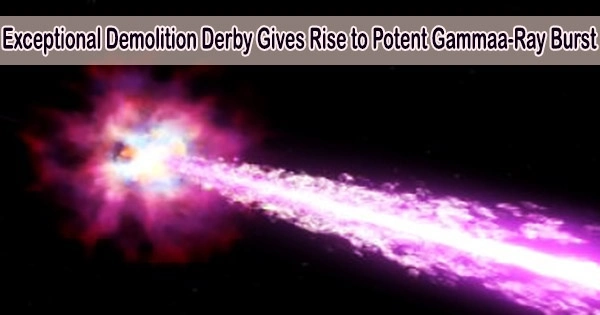An international team of astronomers may have discovered a brand-new method of star destruction while looking for the causes of a strong gamma-ray burst (GRB).
The scientists came to the conclusion that GRB 191019A arose from the collision of stars or stellar remnants in the dense environment surrounding a supermassive black hole at the center of an old galaxy, even though most GRBs come from exploding massive stars or neutron-star mergers. The environment resembles a demolition derby, which suggests a long-theorized but never-observed method of destroying a star and producing a GRB.
The study was published in the journal Nature Astronomy. Led by Radboud University in the Netherlands, the research team included astronomers from Northwestern University.
“For every hundred events that fit into the traditional classification scheme of gamma-ray bursts, there is at least one oddball that throws us for a loop,” said Northwestern astrophysicist and study co-author Wen-fai Fong, “However, it is these oddballs that tell us the most about the spectacular diversity of explosions that the universe is capable of.”
“The discovery of these extraordinary phenomena within dense stellar systems, especially those encircling supermassive black holes at the cores of galaxies, is undeniably exciting,” said Northwestern astrophysicist and study co-author Giacomo Fragione. “This remarkable discovery grants us a tantalizing glimpse into the intricate dynamics at work within these cosmic environments, establishing them as factories of events that would otherwise be deemed impossible.”
Fong is an assistant professor of physics and astronomy at Northwestern’s Weinberg College of Arts and Sciences and a member of the Center for Interdisciplinary Exploration and Research in Astrophysics (CIERA). Fragione is a research assistant professor in CIERA. Other Northwestern co-authors include Anya Nugent and Jillian Rastinejad both Ph.D. students in astronomy and members of Fong’s research group.
Most stars die, according to their mass, in one of three predictable ways. Age-related layer loss occurs in relatively low-mass stars like our sun, which eventually causes them to fade away and become white dwarf stars.
On the other hand, more massive stars burn hotter and supernovae explode more quickly, producing very dense objects like neutron stars and black holes. The third scenario involves a binary system of two such star remnants that eventually collides.
While long GRBs are never found in galaxies as old and dead as GRB 191019A’s host, short GRBs, with their merger origins, have not been observed to be so connected to their hosts’ nuclei. The discovery of this event in the core of its old, quiescent galaxy opens the door to promising new avenues for the formation of binary systems that have rarely been observed before.
Anya Nugent
But the new study finds there might be a fourth option.
“Our results show that stars can meet their demise in some of the densest regions of the universe, where they can be driven to collide,” said lead author Andrew Levan, an astronomer with Radboud University. “This is exciting for understanding how stars die and for answering other questions, such as what unexpected sources might create gravitational waves that we could detect on Earth.”
Ancient galaxies, long past the peak of star formation, have few, if any, big stars left. However, the centers of these objects are teeming with stars and a variety of ultra-dense stellar remnants, including black holes, neutron stars, and white dwarfs.
Astronomers have long hypothesized that a GRB might eventually be created by the collision of two star objects in the tumultuous hubbub of activity that surrounds a supermassive black hole. But evidence for that type of merger has remained elusive.
On Oct. 19, 2019, astronomers glimpsed the first hints of such an event when NASA’s Neil Gehrels Swift Observatory detected a bright flash of gamma rays that lasted a little over one minute. Any GRB lasting longer than two seconds is considered “long.” Such bursts typically come from the collapse of stars at least 10 times the mass of our sun.
The researchers then used the Gemini South telescope in Chile part of the International Gemini Observatory operated by the National Science Foundation’s NOIRLab to make long-term observations of the GRB’s fading afterglow.
These measurements allowed the astronomers to narrow down the GRB’s position to a region fewer than 100 light-years from the galaxy’s supermassive black hole in its core. Curiously, the scientists discovered no sign of a comparable supernova, which would have left its mark on the light that Gemini South had observed.
“The lack of a supernova accompanying the long GRB 191019A tells us that this burst is not a typical massive star collapse,” said Rastinejad, who performed calculations to ensure a supernova was not hiding within the data. “The location of GRB 191019A, embedded in the nucleus of the host galaxy, teases a predicted but not yet evidenced theory for how gravitational-wave emitting sources might form.”
It is extremely uncommon for colliding stellar remnants like neutron stars and black holes to produce extended GRBs in ordinary galactic environments. However, the centers of ancient galaxies are anything but ordinary, with a million or more stars possibly crowded into a space only a few light-years across.
A supermassive black hole’s enormous gravitational pull may be strong enough to cause occasional stellar collisions, which would cause the stars’ movements to be perturbed and send them careening in random directions. These errant stars would eventually collide and merge, causing a massive explosion that could be seen from a great distance in the cosmos.
“This event confounds almost every expectation we have for the environments of short and long GRBs,” said Nugent, who performed crucial modeling of the host galaxy.
“While long GRBs are never found in galaxies as old and dead as GRB 191019A’s host, short GRBs, with their merger origins, have not been observed to be so connected to their hosts’ nuclei. The discovery of this event in the core of its old, quiescent galaxy opens the door to promising new avenues for the formation of binary systems that have rarely been observed before.”
It’s likely that these occurrences are common in equally populated areas of the cosmos but haven’t been spotted before. Due to the abundance of dust and gas in galactic cores, it is possible that both the initial flash of the GRB and its subsequent afterglow be obscured. GRB 191019A may be a rare exception, allowing astronomers to detect the burst and study its aftereffects.
“While this event is the first of its kind to be discovered, it’s possible there are more out there that are hidden by the large amounts of dust close to their galaxies,” Fong said. “Indeed, if this long-duration event came from merging compact objects, it contributes to the growing population of GRBs that defies our traditional classifications.”
The goal of the research is to find more of these occurrences so that they can be matched with gravitational-wave detections, which would tell more about their true nature and confirm their origins even in the most ambiguous circumstances. The Vera C. Rubin Observatory, when it comes online in 2025, will be invaluable in this kind of research.
The study, “A long-duration gamma-ray burst of dynamical origin from the nucleus of an ancient galaxy,” is published in Nature Astronomy.
















